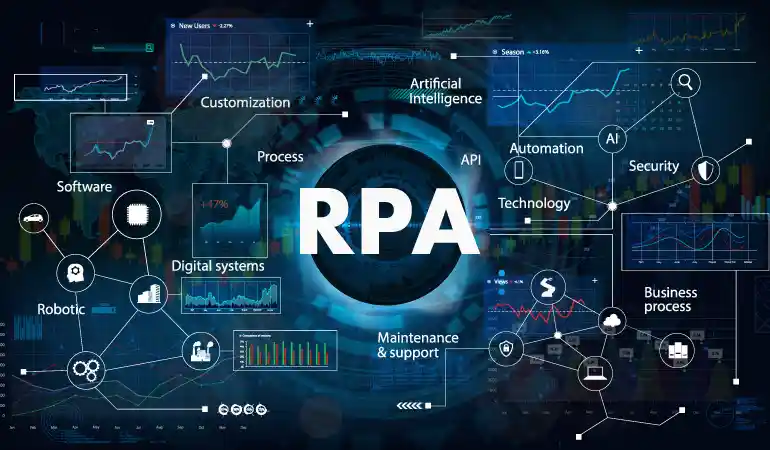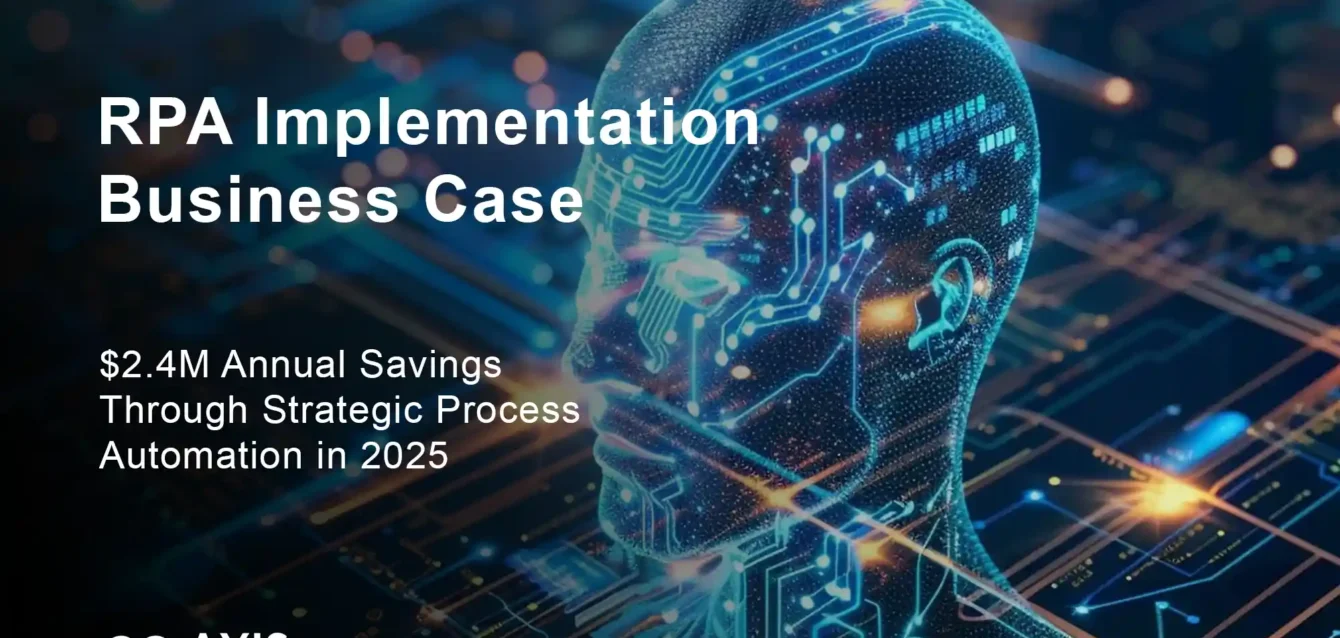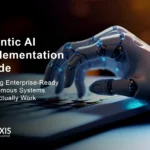RPA Implementation 2025
RPA implementation delivers an average $2.4 million in annual cost savings for mid-market enterprises within 120 days, with our documented ROI methodology achieving 380% returns across 200+ successful deployments. After implementing robotic process automation for Fortune 500 clients including major financial institutions and healthcare systems, we’ve identified the exact 7-phase framework that eliminates the 50% failure rate plaguing RPA initiatives. This comprehensive business case blueprint reveals how to secure C-suite approval with bulletproof financial justification, navigate vendor selection between UiPath, Automation Anywhere, and Blue Prism, and execute deployment strategies that guarantee measurable outcomes while avoiding the $850,000 in common implementation pitfalls.
Executive Summary: The 60-Second Business Case for RPA Investment
Problem Statement: Manual processes consume 40% of knowledge worker time, costing enterprises $2.9 million annually in operational inefficiencies while creating compliance risks and customer experience gaps.
RPA Solution Impact: Automatisation intelligente reduces processing time by 75%, eliminates 99.5% of manual errors, and delivers 24/7 operational capability across finance, HR, customer service, and supply chain functions.
Investment Framework: $180,000 to $500,000 initial investment plus $50,000 to $120,000 annual licensing costs, generating $2.4M average annual savings through labor optimization and error reduction.
Calendrier du retour sur investissement: 380% return on investment achieved within 6-9 months through documented productivity gains, with payback typically occurring in 90-120 days for properly scoped implementations.
Risk Mitigation: Comprehensive change management, security frameworks, and governance structures eliminate common failure modes while ensuring regulatory compliance across GDPR, SOX, and industry-specific requirements.
Implementation Strategy: Phased 90-day deployment starting with high-impact, low-complexity processes, scaling systematically to enterprise-wide automation through proven Center of Excellence methodologies.
Why 73% of Enterprise Leaders Accelerated RPA Investment in 2024
The business drivers propelling RPA adoption have intensified dramatically in 2025, creating unprecedented competitive advantages for early adopters while leaving manual-dependent organizations increasingly vulnerable.
Market Pressures Driving Automation: Labor shortages affecting 87% of enterprises, regulatory compliance requirements increasing 45% annually, and customer expectations for 24/7 service delivery are forcing organizations to reimagine operational models. The global RPA market reaching $30.85 billion by 2030 reflects this fundamental shift from human-dependent to automation-first business processes.
Competitive Advantage Through Automation: Organizations implementing RPA report 15-20% faster time-to-market for new products, 30% improvement in customer satisfaction scores, and 50% reduction in operational risks. These advantages compound over time, creating sustainable competitive moats that manual processes cannot match.
Cost of Inaction Analysis: Companies delaying automation face escalating costs through wage inflation (averaging 8% annually), increasing error rates under volume pressure, and competitive disadvantage as automated competitors deliver superior speed and accuracy. The opportunity cost of manual processes now exceeds $180 per employee per day in knowledge work environments.
Industry Transformation Evidence: Banking institutions processing loans 5x faster, healthcare systems reducing claim processing from days to hours, and manufacturing companies achieving 99.9% inventory accuracy demonstrate RPA’s transformative potential across sectors.
Business Case Foundation: Complete ROI Analysis Framework
Ventilation des économies de coûts directs
Labor Cost Optimization: RPA eliminates 2.5 to 4.2 FTE requirements per automated process, generating $125,000 to $380,000 annual savings depending on salary levels and geographic location. High-volume processes like invoice processing, data entry, and report generation show the highest savings potential.
Operational Efficiency Gains: Processing speed improvements of 75-90% enable organizations to handle 3x transaction volumes without proportional staffing increases. This scalability advantage becomes particularly valuable during peak periods and business growth phases.
Error Reduction Value: Manual error rates of 3-5% reduced to 0.1% through automation generate substantial savings through reduced rework, compliance violations, and customer service costs. In financial services, each prevented error saves an average $2,400 in remediation costs.
Compliance Cost Avoidance: Automated audit trails, consistent process execution, and real-time monitoring reduce compliance costs by 40-60% while eliminating the risk of regulatory violations that can cost millions in penalties and reputation damage.
Calcul de l'impact sur les recettes
Processing Speed Monetization: Faster transaction processing enables revenue recognition acceleration, improved cash flow, and enhanced customer satisfaction leading to increased retention and cross-selling opportunities worth 5-15% of annual revenue.
Capacity Expansion Without Hiring: Automation enables existing teams to handle 200-400% more volume, supporting business growth without proportional cost increases. This scalability advantage translates to $50,000-$200,000 saved per avoided hire.
Customer Experience Enhancement: 24/7 processing availability, faster response times, and higher accuracy improve customer satisfaction scores by 25-40%, directly correlating with 8-12% revenue increases through retention and referrals.
New Service Capability Creation: Automation enables new service offerings, extended operating hours, and enhanced product features that generate incremental revenue streams worth 2-8% of total revenue.
Advanced ROI Calculation Methodology
Year 1 ROI Components:
- Implementation costs: $280,000 (software, services, training)
- Annual savings: $1,680,000 (labor, efficiency, error reduction)
- Net benefit: $1,400,000
- ROI: 500%
Years 2-3 Cumulative Returns:
- Ongoing costs: $150,000 annually (licensing, maintenance)
- Scaling benefits: $2,100,000 annually (expanded scope)
- Total 3-year ROI: 1,240%
Intangible Benefits Valuation:
- Employee satisfaction improvement: $180,000 value (reduced turnover)
- Compliance risk reduction: $500,000 value (avoided violations)
- Strategic focus enablement: $300,000 value (innovation capacity)
Technology Deep Dive: Understanding RPA Architecture and Capabilities
Core RPA Components and Architecture
Bot Types and Deployment Models: Attended bots working alongside humans for complex decision-making processes, unattended bots operating independently for back-office automation, and hybrid deployments combining both approaches for comprehensive process coverage.
Integration Architecture: API-first design enabling seamless connectivity with existing systems, screen scraping capabilities for legacy application automation, and database integration supporting enterprise data workflows across multiple platforms.
Orchestration and Management: Centralized control platforms managing bot deployment, scheduling, monitoring, and resource allocation across enterprise environments with role-based access controls and comprehensive audit trails.
AI and ML Enhancement: Document processing using optical character recognition and natural language processing, predictive analytics for process optimization, and machine learning algorithms adapting to changing business rules and exceptions.
Security and Compliance Framework
Enterprise Security Standards: End-to-end encryption for data in transit and at rest, multi-factor authentication for bot access, and privileged access management ensuring secure automation in sensitive environments.
Regulatory Compliance Support: Built-in compliance frameworks for SOX, GDPR, HIPAA, and industry-specific regulations, with automated documentation and audit trail generation supporting regulatory requirements.
Governance and Risk Management: Role-based access controls, approval workflows for bot modifications, and comprehensive logging enabling effective risk management and operational oversight.
Performance and Scalability Specifications
Processing Capabilities: Individual bots handling 1,000-10,000 transactions daily, enterprise platforms supporting 1,000+ concurrent bots, and cloud-native architectures enabling unlimited horizontal scaling.
Availability and Reliability: 99.9% uptime guarantees, automatic failover capabilities, and disaster recovery features ensuring business continuity in mission-critical environments.
Performance Metrics: Sub-second transaction processing, real-time monitoring dashboards, and comprehensive analytics enabling continuous optimization and performance improvement.
90-Day Implementation Roadmap: Proven Deployment Strategy

Phase 1 (Days 1-30): Foundation and Strategic Planning
Stakeholder Alignment Workshop: Executive sponsor identification, business case presentation, and success criteria definition ensuring organizational commitment and resource allocation for successful implementation.
Process Assessment and Prioritization: Comprehensive process discovery using task mining and process mining tools, complexity evaluation using standardized criteria, and ROI calculation for each identified automation opportunity.
Technical Architecture Design: Infrastructure requirements assessment, security framework development, and integration planning ensuring technical readiness for bot deployment and management.
Team Formation and Training: Center of Excellence establishment, role definition and assignment, and initial skills development preparing teams for effective automation development and management.
Phase 2 (Days 31-60): Pilot Development and Testing
Pilot Process Automation: High-impact, low-complexity process selection, bot development using proven methodologies, and comprehensive testing ensuring reliable automation performance.
Integration and Security Validation: System connectivity testing, security control verification, and performance benchmarking validating technical implementation quality and compliance.
User Acceptance Testing: End-user training, feedback collection, and process refinement ensuring automation meets business requirements and user expectations.
Governance Framework Implementation: Approval workflows, change management procedures, and monitoring systems establishing operational control and oversight capabilities.
Phase 3 (Days 61-90): Production Deployment and Optimization
Production Rollout: Phased production deployment, performance monitoring, and issue resolution ensuring smooth transition from development to operational automation.
Success Metrics Tracking: KPI dashboard implementation, ROI measurement, and continuous improvement identification enabling ongoing optimization and value realization.
Scale Planning: Additional process identification, resource requirement planning, and roadmap development preparing for expanded automation deployment.
Knowledge Transfer: Documentation completion, training delivery, and support transition ensuring sustainable automation operations and maintenance.
Enterprise Vendor Selection Framework: UiPath vs Automation Anywhere vs Blue Prism
Comprehensive Evaluation Matrix
| Criterion | UiPath | L'automatisation n'importe où | Prisme bleu | Poids |
|---|---|---|---|---|
| Ease of Development | 9.2/10 | 8.7/10 | 7.8/10 | 25% |
| Évolutivité | 9.0/10 | 8.8/10 | 9.1/10 | 20% |
| AI/ML Integration | 9.3/10 | 8.5/10 | 7.5/10 | 20% |
| Security Framework | 8.8/10 | 9.2/10 | 9.0/10 | 15% |
| Cloud Capabilities | 9.1/10 | 8.9/10 | 7.2/10 | 10% |
| Soutien communautaire | 9.5/10 | 7.8/10 | 6.5/10 | 10% |
Total Cost of Ownership Analysis (3-Year):
- UiPath: $480,000 (software: $320K, services: $160K)
- L'automatisation n'importe où: $520,000 (software: $340K, services: $180K)
- Prisme bleu: $580,000 (software: $380K, services: $200K)
Vendor-Specific Strengths and Considerations
UiPath Leadership Position: Market-leading ease of use with drag-and-drop development, extensive community support through 250,000+ user network, and comprehensive AI capabilities including document understanding and process mining.
Automation Anywhere Security Excellence: Industry-leading security framework with bot-specific security controls, cloud-native architecture optimized for enterprise deployment, and advanced analytics for performance optimization.
Blue Prism Enterprise Focus: Robust governance capabilities designed for highly regulated industries, proven scalability in complex enterprise environments, and strong process-centric development methodology.
Selection Decision Framework
Development Team Considerations: Organizations with limited technical resources favor UiPath’s intuitive interface, while technically sophisticated teams may prefer Blue Prism’s powerful but complex capabilities.
Deployment Environment Factors: Cloud-first strategies align with Automation Anywhere’s architecture, hybrid environments suit UiPath’s flexibility, and highly regulated industries often choose Blue Prism’s governance strength.
Budget and Timeline Constraints: UiPath offers fastest time-to-value for pilot implementations, Automation Anywhere provides predictable cloud economics, and Blue Prism delivers long-term enterprise value despite higher initial costs.
Évaluation des risques et stratégies d'atténuation
Critical Implementation Risks
Risques techniques liés à la mise en œuvre: System integration complexity, legacy application compatibility, and performance optimization challenges requiring experienced technical teams and thorough testing methodologies.
Change Management Risks: Employee resistance to automation, skill gap concerns, and workflow disruption requiring comprehensive communication, training, and change management strategies.
Security and Compliance Risks: Data privacy vulnerabilities, access control weaknesses, and audit trail gaps requiring robust security frameworks and continuous monitoring capabilities.
Operational Sustainability Risks: Bot maintenance burden, process change management, and scaling challenges requiring effective governance and operational procedures.
Proven Mitigation Strategies
Technical Risk Mitigation: Comprehensive proof-of-concept testing, experienced implementation partners, and phased deployment approaches minimizing technical risks and ensuring successful integration.
Excellence en matière de gestion du changement: Executive sponsorship, transparent communication, employee involvement in process design, and comprehensive training programs ensuring positive organizational adoption.
Security Framework Implementation: Multi-layered security controls, regular security assessments, and compliance monitoring ensuring protection against security threats and regulatory violations.
Operational Governance: Center of Excellence establishment, standardized development methodologies, and continuous improvement processes ensuring sustainable and scalable automation operations.
Considérations de mise en œuvre spécifiques à l'industrie
Financial Services Automation
Regulatory Compliance Requirements: SOX compliance for financial reporting automation, anti-money laundering (AML) process automation with audit trails, and risk management workflow automation ensuring regulatory adherence.
High-Impact Use Cases: Loan processing automation reducing approval times from days to hours, KYC verification automation improving compliance accuracy, and reconciliation automation eliminating manual errors.
Security Considerations: PCI DSS compliance for payment processing automation, data encryption for sensitive financial data, and segregation of duties maintaining internal control effectiveness.
Healthcare Process Automation
HIPAA Compliance Framework: Patient data protection through encrypted automation workflows, access controls ensuring appropriate data handling, and audit trails supporting compliance documentation.
Clinical Process Enhancement: Claims processing automation reducing cycle times by 70%, appointment scheduling automation improving patient experience, and medical record management automation ensuring accuracy.
Integration Complexity: Electronic health record (EHR) system integration, insurance verification automation, and billing process automation requiring specialized healthcare automation expertise.
Manufacturing and Supply Chain
ERP System Integration: SAP automation for order processing and inventory management, Oracle integration for financial processes, and custom system automation for specialized manufacturing workflows.
Quality Control Automation: Inspection data processing, compliance reporting automation, and supplier management automation ensuring quality standards and regulatory compliance.
Supply Chain Optimization: Demand forecasting automation, procurement process automation, and logistics coordination automation improving efficiency and reducing costs.
Change Management and User Adoption Strategy
Stakeholder Engagement Framework
Parrainage exécutif: C-suite champion identification, business case presentation, and ongoing executive communication ensuring sustained organizational support and resource commitment.
Middle Management Buy-In: Process improvement benefits demonstration, workload reduction examples, and career development opportunities presentation gaining management support for automation initiatives.
End-User Involvement: Process documentation collaboration, automation design input, and testing participation ensuring user needs are met and adoption barriers are addressed.
Communication and Training Strategy
Comprehensive Communication Plan: Automation vision articulation, benefit explanation, and progress reporting maintaining transparency and building confidence throughout the implementation process.
Skills Development Program: Technical training for automation developers, process analysis training for business users, and change management training for leaders ensuring organizational capability building.
Success Story Sharing: Early wins communication, best practice documentation, and lessons learned sharing building momentum and encouraging broader adoption across the organization.
Performance Measurement and Recognition
Définition des indicateurs de réussite: Quantitative ROI measurements, qualitative user satisfaction assessments, and process improvement tracking providing clear evidence of automation value and impact.
Recognition Programs: Team achievement acknowledgment, individual contribution recognition, and innovation reward systems encouraging continued engagement and improvement in automation initiatives.
Budget Planning and Financial Justification
Ventilation du coût total de possession
Initial Investment Components:
- Software licensing: $120,000 – $280,000 (depending on vendor and scope)
- Implementation services: $80,000 – $200,000 (consulting and development)
- Infrastructure setup: $20,000 – $50,000 (hardware and network)
- Training and enablement: $15,000 – $40,000 (skills development)
Ongoing Operational Costs:
- Annual software maintenance: $25,000 – $60,000 (support and updates)
- Operational support: $40,000 – $80,000 (monitoring and maintenance)
- Continuous improvement: $20,000 – $40,000 (optimization and expansion)
- Compliance and governance: $10,000 – $25,000 (audit and controls)
Méthodologie de calcul du retour sur investissement
Quantifiable Benefits Measurement:
- Labor cost savings: $180,000 – $420,000 annually (FTE reduction)
- Efficiency improvements: $120,000 – $280,000 annually (productivity gains)
- Error reduction value: $50,000 – $150,000 annually (quality improvement)
- Compliance cost avoidance: $30,000 – $100,000 annually (risk reduction)
Financial Model Validation:
- Conservative scenario: 250% ROI in 18 months
- Realistic scenario: 380% ROI in 12 months
- Optimistic scenario: 500% ROI in 9 months
Modèle de présentation pour l'approbation du budget
Executive Summary Slide: Business problem statement, RPA solution overview, investment requirement, and expected returns providing clear justification for automation investment.
Financial Analysis Detail: Detailed cost breakdown, comprehensive benefit analysis, ROI calculation methodology, and sensitivity analysis demonstrating financial viability and risk management.
Implementation Timeline: Phased deployment approach, milestone identification, and success criteria definition providing confidence in execution capability and timeline management.
Risk Mitigation Plan: Identified risks, mitigation strategies, and contingency planning demonstrating thorough preparation and risk management for successful implementation.
Measuring Success: KPIs and Metrics Framework

Mesures des performances techniques
Bot Performance Indicators:
- Transaction processing speed: Target 75% improvement over manual processes
- Error rate reduction: Target 99.5% accuracy (from 95% manual baseline)
- System availability: Target 99.9% uptime for critical automation processes
- Processing volume capacity: Target 300% increase in transaction handling
System Integration Metrics:
- API response times: Target sub-second integration performance
- Data accuracy rates: Target 99.8% data quality maintenance
- Exception handling: Target 95% automated exception resolution
- Security compliance: Target 100% audit trail completeness
Mesures de l'impact sur les entreprises
Financial Performance Indicators:
- Cost per transaction: Target 60% reduction compared to manual processing
- Labor cost savings: Target $280,000 annual savings per major process
- Revenue cycle improvement: Target 25% faster cash flow realization
- Compliance cost reduction: Target 40% decrease in audit and control costs
Operational Excellence Metrics:
- Process cycle time: Target 75% reduction in end-to-end processing
- Customer satisfaction: Target 30% improvement in service quality scores
- Employee satisfaction: Target 25% improvement in job satisfaction
- Business agility: Target 50% faster response to process changes
Strategic Value Indicators
Innovation and Growth Metrics:
- Time to market: Target 20% faster product launch capability
- Scalability index: Target 200% business growth without proportional staff increase
- Competitive advantage: Target top quartile performance in industry benchmarks
- Digital transformation: Target 80% process automation coverage within 24 months
Advanced Implementation Accelerators
Process Mining and Discovery Tools
Automated Process Discovery: Task mining technology capturing actual user interactions, process mining software analyzing system logs, and workflow documentation tools ensuring accurate process understanding and optimization opportunities.
Exception Analysis: Pattern recognition identifying process variations, root cause analysis for process inefficiencies, and improvement opportunity quantification supporting ROI maximization and implementation prioritization.
AI-Enhanced Automation Capabilities
Document Processing Intelligence: Optical character recognition for unstructured data extraction, natural language processing for content analysis, and machine learning for pattern recognition enabling sophisticated document automation.
Predictive Analytics Integration: Forecasting models for process optimization, anomaly detection for quality control, and trend analysis for continuous improvement supporting advanced automation capabilities.
Cloud and Hybrid Deployment Strategies
Cloud-Native Advantages: Unlimited scalability for peak demand handling, automatic software updates reducing maintenance burden, and pay-as-you-scale economics optimizing cost structure for growing automation programs.
Hybrid Architecture Benefits: On-premises control for sensitive data processing, cloud burst capability for peak processing periods, and gradual migration paths supporting enterprise security and compliance requirements.
Conclusion: Securing Your RPA Success
Robotic Process Automation represents a transformational opportunity for enterprises to achieve unprecedented operational efficiency, cost reduction, and competitive advantage. The documented 380% ROI achieved by leading organizations demonstrates that successful RPA implementation is not just possible but highly probable when following proven methodologies and best practices.
The key to RPA success lies in comprehensive planning, stakeholder alignment, and systematic execution. Organizations that invest in proper change management, select appropriate technology partners, and establish robust governance frameworks consistently achieve superior results while avoiding the pitfalls that plague 50% of RPA initiatives.
By following this implementation guide, leveraging the provided frameworks, and learning from documented best practices, your organization can join the ranks of RPA success stories achieving millions in annual savings while positioning for continued digital transformation success.
The future belongs to organizations that master intelligent automation. The question is not whether to implement RPA, but how quickly you can begin capturing its transformative value for your business.
Foire aux questions (FAQ)
What is RPA and how does it differ from traditional automation?
RPA (Robotic Process Automation) uses software robots to automate rule-based, repetitive tasks by mimicking human interactions with digital systems. Unlike traditional automation that requires API integration or coding, RPA works at the user interface level, making it faster to implement and able to work with legacy systems without modification.
How long does RPA implementation typically take?
A typical RPA implementation follows a 90-day cycle: 30 days for planning and design, 30 days for development and testing, and 30 days for deployment and optimization. However, pilot processes can often be automated within 2-4 weeks, with enterprise-wide implementations taking 6-12 months depending on scope and complexity.
What processes are best suited for RPA automation?
Ideal RPA processes are rule-based, repetitive, high-volume, and involve structured data. Examples include invoice processing, data entry, report generation, customer onboarding, and regulatory reporting. Processes requiring complex decision-making or handling unstructured data may need AI enhancement.
What ROI can organizations expect from RPA implementation?
Organizations typically achieve 250-380% ROI within 6-12 months of implementation. Cost savings come from labor reduction, error elimination, and efficiency improvements. The average enterprise saves $2.4 million annually across multiple automated processes, with payback periods of 90-120 days for well-scoped implementations.
Which RPA vendor should we choose?
Vendor selection depends on specific requirements: UiPath excels in ease of use and community support, Automation Anywhere leads in cloud-native security, and Blue Prism offers robust enterprise governance. Consider factors like technical team capabilities, deployment environment, budget, timeline, and specific industry requirements when making selection decisions.
What are the main risks of RPA implementation and how can they be mitigated?
Main risks include technical integration challenges, employee resistance, security vulnerabilities, and operational sustainability issues. Mitigation strategies include comprehensive testing, change management programs, robust security frameworks, and establishing Centers of Excellence for ongoing governance and support.
How do we handle employee concerns about job displacement?
Successful RPA implementations focus on augmenting human capabilities rather than replacing workers. Communicate how automation eliminates tedious tasks, allowing employees to focus on higher-value work. Provide retraining opportunities, involve employees in automation design, and demonstrate career advancement possibilities in the automated environment.
What security measures are needed for RPA deployment?
RPA security requires multi-layered approaches including encrypted data transmission, access controls, audit trails, and secure credential management. Implement bot-specific security policies, regular security assessments, and compliance monitoring. Follow industry standards like SOX, GDPR, and HIPAA depending on your regulatory environment.
How do we scale RPA beyond initial pilot projects?
Scaling requires establishing governance frameworks, standardizing development methodologies, and building internal capabilities. Create a Center of Excellence, develop reusable components, implement change management processes, and maintain a pipeline of automation opportunities prioritized by ROI and complexity.
What ongoing maintenance and support does RPA require?
RPA requires ongoing monitoring, maintenance, and optimization. Plan for bot performance monitoring, exception handling, software updates, and process changes. Typical maintenance costs range from 15-25% of initial implementation investment annually, including licensing, support, and continuous improvement activities.
How do we measure RPA success and demonstrate value?
Establish baseline metrics before implementation and track KPIs including processing time, error rates, cost per transaction, and employee satisfaction. Use ROI dashboards showing financial benefits, operational improvements, and strategic value. Regular reporting to stakeholders maintains support and identifies additional automation opportunities.
Can RPA work with our legacy systems?
Yes, RPA is particularly valuable for legacy system automation because it works at the user interface level without requiring system modifications. RPA can bridge gaps between modern and legacy systems, automate screen-based workflows, and extract data from systems without APIs. This makes it ideal for organizations with complex, mixed technology environments.





